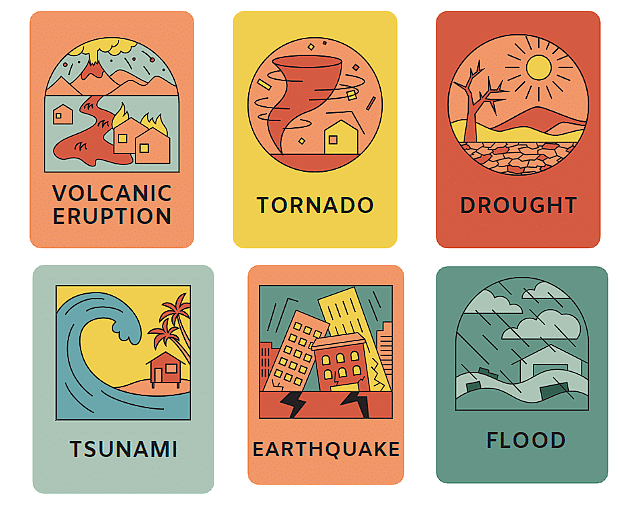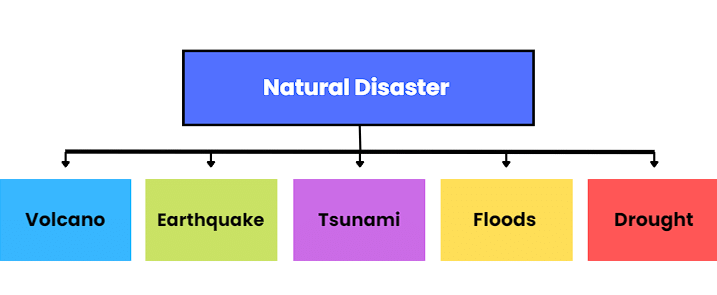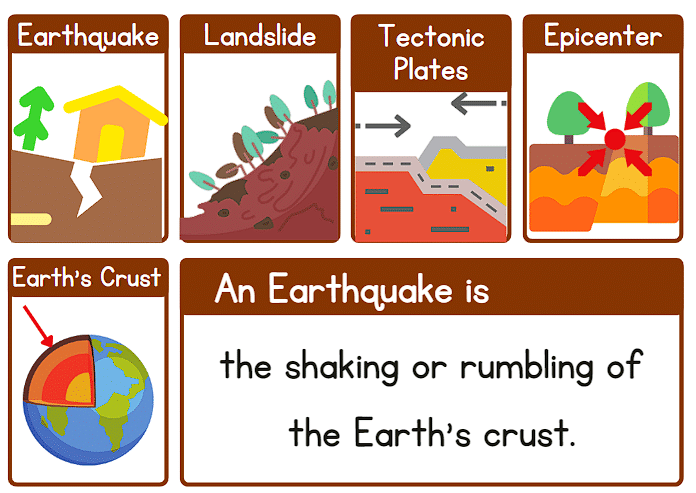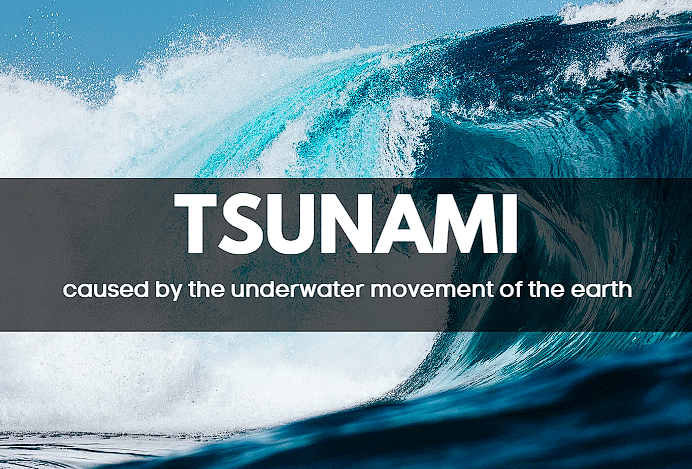Natural Calamities Class 5 Notes Science
| Table of contents |

|
| What is a Natural disaster? |

|
| Different Types of Natural Disasters |

|
| 1. Volcano |

|
| 2. Earthquake |

|
| 3. Tsunami |

|
| 4. Floods |

|
Humans need nature for many things. Earth is the only planet in our solar system where life can exist. When big problems like loss of life, injuries, and damage to the environment and economy happen because of natural events, we call them natural disasters.
Examples include volcanoes, tsunamis, floods, droughts, and cyclones. These disasters can happen anywhere on Earth. While we can't stop them from occurring, we can take steps to reduce the harm they cause to people and property.
 Natural Disaster
Natural Disaster
What is a Natural disaster?
A natural disaster is the damage or destruction caused by natural forces. It results in a great loss of life and property. Natural disasters are big, powerful events caused by nature, not people. They can hurt or kill people and damage things like homes and buildings.
Different Types of Natural Disasters

1. Volcano
A volcano is a fracture in the Earth's surface or crust, allowing for the release of hot molten rock, ash, and gases from within the Earth.
Deep within the Earth lies magma, a hot molten rock. This magma reaches the surface through vents, and upon emerging, it's referred to as lava. As lava cools and solidifies, it forms rocks.
Volcanoes are categorized into three types
(a) Active Volcanoes
These volcanoes are prone to erupting at any time or have erupted recently, with "recent" defined by geologists as potentially spanning thousands of years. The region encircling the Pacific Ocean, known as the 'Pacific Ring of Fire', is renowned for its numerous active volcanoes such as Mount Vesuvius, Mount Fuji, Mount Erebus, and Mount Etna.
(b) Dormant Volcanoes
Dormant volcanoes haven't erupted for a significant period but may potentially erupt in the foreseeable future. For instance, Mount Fujiyama in Japan falls into this category.
(c) Extinct Volcanoes
These are volcanoes that have ceased erupting, remaining dormant for thousands of years. Mount Pope in Myanmar and Mount Kilimanjaro in Africa are examples of extinct volcanoes.
 Types of Volcanoes and their examples
Types of Volcanoes and their examples
2. Earthquake
An earthquake is when the ground suddenly shakes or moves. It happens because of a lot of energy being released from deep within the Earth. This energy makes the ground shake. It's a natural event that can be really strong or just a little shake.

- An earthquake happens when the ground suddenly shakes because of strong waves deep underground. It's like the Earth's puzzle pieces(called plates)moving and bumping into each other. The place deep down where the shaking begins is called the focus, and the place on the surface right above it is called the epicenter.
- Scientists who study earthquakes are called seismologists. They use a machine called a seismograph and a scale called the Richter scale to measure how strong earthquakes are. Sometimes, after a big earthquake, smaller shakes called aftershocks can happen.
- Earthquakes can be dangerous. They can make buildings crack or collapse, start fires, and even create big waves in the ocean calledtsunamis.So, when we feel an earthquake, it's important to get outside and stay away from tall buildings, trees, and power lines. If we can't move, it's best to get under a sturdy table to stay safe. And even after the shaking stops, we should be careful because there might be more shaking later.
3. Tsunami
Tsunami, which means "harbor wave" in Japanese, is often referred to as tidal waves. It occurs when there are undersea earthquakes, volcanic eruptions, or landslides. These events can create huge waves that crash onto the shore, causing a lot of damage in coastal areas. Tsunamis can be incredibly tall, reaching heights of 10-30 meters, and they move very fast, sometimes up to 1000 km/hour, covering long distances before hitting land.

One of the scariest tsunamis happened in 2004 in the Indian Ocean. It happened because of a huge earthquake near Indonesia and it caused a lot of destruction, hurting many people and destroying homes.
To stay safe from tsunamis:
(a) We can set up special alarms that go off when a tsunami might happen.
(b) If we're near the ocean and hear about a tsunami, we should try to go to higher ground, like a hill or a tall building.
(c) Planting trees called mangroves along the coast can help soften the impact of the waves.
(d) Building really strong walls along the coast out of tough materials like concrete can also help protect us from tsunamis.
4. Floods
A flood happens when there's too much water on land. It can occur if a river gets too much water from heavy rains or if a dam breaks. Floods can also happen if the sea level rises or if snow melts quickly in the mountains. Cyclones and tsunamis near the ocean can cause floods too. Landslides or strong tides can block rivers, leading to floods. Floods can be very bad, damaging homes and hurting people. They can also spread diseases through dirty water and make it hard to find clean water to drink.
|
42 videos|230 docs|45 tests
|
FAQs on Natural Calamities Class 5 Notes Science
| 1. What is a natural disaster? |  |
| 2. What are the different types of natural disasters? |  |
| 3. How do volcanoes cause natural disasters? |  |
| 4. What causes earthquakes? |  |
| 5. How do tsunamis form? |  |
















